INSTITUT SUPERIEUR D'ANTHROPOLOGIE
INSTITUT OF ANTHROPOLOGY
COURS ONLINE – COURS A DISTANCE
INSCRIPTIONS OUVERTES
REGISTER NOW
CHINE – 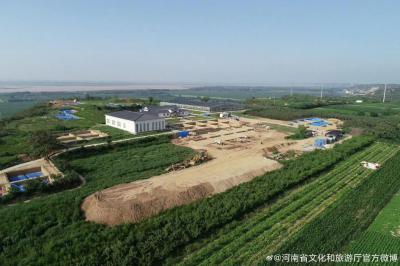 Shuanghuaishu - By examining the human bone remains discovered from the Shuanghuaishu ruin, an archaeological site dubbed the “seed of early Chinese civilization,” researchers recently found that the site’s residents commonly experienced a dental problem dating back 5300 years ago. The issue was caries, still often seen in modern life. Led by Zhou Yawei, a professor at Zhengzhou University, the research team identified the youngest “patient” with caries at around 4 years old, with seven out of ten individuals having the dental problem. Located in Gongyi, Central China’s Henan Province, Shuanghuaishu belongs to China’s Yangshao culture, mainly distributed in the middle and lower reaches of the Yellow River. Archaeologist Wang Meng told the Global Times that the natural conditions, including warm and moist weather, were conducive to the local ancient people growing grain, especially millet. “Many of the Yangshao culture’s iconic pottery relics were once designed to store and plate such foods,” Wang said. Such a staple food contains high sugar content, the "major reason" why the caries problem was common among ancient people in the Shuanghuaishu area, explained Zhou, the expert. The dental problem of ancient people may be considered a novelty, yet it can “reflect China’s long-standing agricultural civilization,” remarked Zhou. In addition to maintaining the “millets” growing tradition, a silkworm sculpture and some silk textile segments have also been excavated from the site along with grains scattered around. This discovery reveals an innovative agricultural model designed by ancient Chinese people to combine farming and mulberry industries.“The model has later been inherited to nowadays. It was seen as the most suitable one for the Central Plain’s agricultural developments,” Wang told the Global Times.
Shuanghuaishu - By examining the human bone remains discovered from the Shuanghuaishu ruin, an archaeological site dubbed the “seed of early Chinese civilization,” researchers recently found that the site’s residents commonly experienced a dental problem dating back 5300 years ago. The issue was caries, still often seen in modern life. Led by Zhou Yawei, a professor at Zhengzhou University, the research team identified the youngest “patient” with caries at around 4 years old, with seven out of ten individuals having the dental problem. Located in Gongyi, Central China’s Henan Province, Shuanghuaishu belongs to China’s Yangshao culture, mainly distributed in the middle and lower reaches of the Yellow River. Archaeologist Wang Meng told the Global Times that the natural conditions, including warm and moist weather, were conducive to the local ancient people growing grain, especially millet. “Many of the Yangshao culture’s iconic pottery relics were once designed to store and plate such foods,” Wang said. Such a staple food contains high sugar content, the "major reason" why the caries problem was common among ancient people in the Shuanghuaishu area, explained Zhou, the expert. The dental problem of ancient people may be considered a novelty, yet it can “reflect China’s long-standing agricultural civilization,” remarked Zhou. In addition to maintaining the “millets” growing tradition, a silkworm sculpture and some silk textile segments have also been excavated from the site along with grains scattered around. This discovery reveals an innovative agricultural model designed by ancient Chinese people to combine farming and mulberry industries.“The model has later been inherited to nowadays. It was seen as the most suitable one for the Central Plain’s agricultural developments,” Wang told the Global Times.
Dental issues unearthed in ancient Chinese remains illuminate agriculture boom 5000 years ago - Global Times
IRAQ – 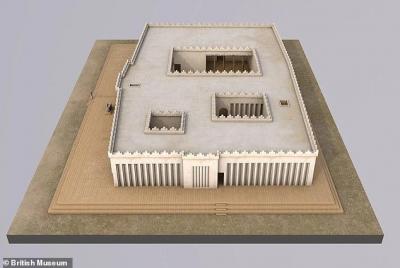
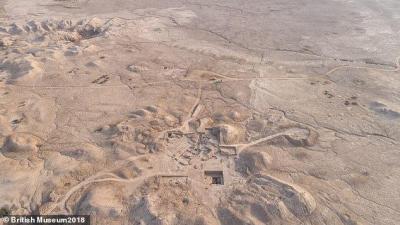
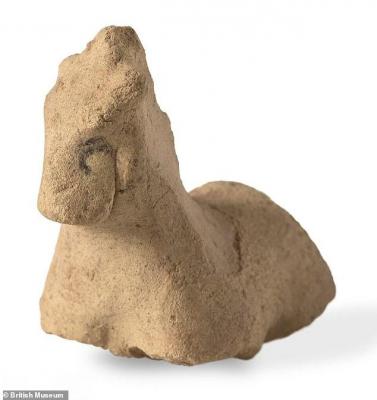 Girsu - The mystery surrounding a 4,000-year-old Iraqi temple has finally been solved as archaeologists uncover signs that Alexander the Great was worshipped as a divine figure.Scientists had been puzzled by the discovery of more recent Greek inscriptions at the ancient Sumerian temple of Girsu, in the modern-day town of Tello. Now, British Museum archaeologists believe a Greek temple to Alexander the Great was founded on the site, possibly by Alexander himself.The discovery of a silver coin minted around 330 BCE by Alexander's troops suggests that the conqueror may have visited the temple after defeating the Persians. This would make founding the temple one of the last acts of Alexander's life, shortly before his death at the age of 32. British Museum archaeologist Dr Sebastien Rey now believes that the Greeks had founded their own temple on the ancient site, potentially to declare the divinity of Alexander. 'It is truly mind-blowing. Our discoveries place the later temple in Alexander’s lifetime,' said Dr Rey'We found offerings, the kinds of offerings that would be given after a battle, figures of soldiers and cavalrymen. 'There is a chance, we will never know for certain, that he might have come here, when he returned to Babylon, just before he died,' Dr Rey told The Telegraph. The discovery of the silver coin alongside an altar with offerings usually found in Greek temples implies the site was being used as a place of worship by Alexander's forces. The offerings included terracotta cavalrymen which were very similar to the 'Companion Cavalry' which formed the personal bodyguard of the young conqueror. The researchers say this could mean that whoever made the offerings was very close to Alexander, or that these were possibly made by the conqueror himself. The discoveries also shed light on the meaning of the cryptic Greek inscription found at the site which referred to the 'giver of the two brothers'. Alexander the Great had an immense personal interest in the figure of Hercules and had declared himself the Son of Zeus while in Egypt, making him the brother of the mythical hero. Alexander may have asked the Sumerian people who most resembled Hercules within their culture and been directed to the temple of Ningirsu the warrior God. Dr Rey believes that the temple was dedicated to Zeus and the two brothers, a combined figure of Hercules and Ningursu, and Alexander the Great. 'This site honours Zeus and two divine sons. The sons are Heracles and Alexander. That is what these discoveries suggest,' says Dr Rey. This theory also suggests that ancient cultures had a deep understanding of their history and a long cultural memory, knowing the exact location of the temple and its use over a millennium after it was abandoned.
Girsu - The mystery surrounding a 4,000-year-old Iraqi temple has finally been solved as archaeologists uncover signs that Alexander the Great was worshipped as a divine figure.Scientists had been puzzled by the discovery of more recent Greek inscriptions at the ancient Sumerian temple of Girsu, in the modern-day town of Tello. Now, British Museum archaeologists believe a Greek temple to Alexander the Great was founded on the site, possibly by Alexander himself.The discovery of a silver coin minted around 330 BCE by Alexander's troops suggests that the conqueror may have visited the temple after defeating the Persians. This would make founding the temple one of the last acts of Alexander's life, shortly before his death at the age of 32. British Museum archaeologist Dr Sebastien Rey now believes that the Greeks had founded their own temple on the ancient site, potentially to declare the divinity of Alexander. 'It is truly mind-blowing. Our discoveries place the later temple in Alexander’s lifetime,' said Dr Rey'We found offerings, the kinds of offerings that would be given after a battle, figures of soldiers and cavalrymen. 'There is a chance, we will never know for certain, that he might have come here, when he returned to Babylon, just before he died,' Dr Rey told The Telegraph. The discovery of the silver coin alongside an altar with offerings usually found in Greek temples implies the site was being used as a place of worship by Alexander's forces. The offerings included terracotta cavalrymen which were very similar to the 'Companion Cavalry' which formed the personal bodyguard of the young conqueror. The researchers say this could mean that whoever made the offerings was very close to Alexander, or that these were possibly made by the conqueror himself. The discoveries also shed light on the meaning of the cryptic Greek inscription found at the site which referred to the 'giver of the two brothers'. Alexander the Great had an immense personal interest in the figure of Hercules and had declared himself the Son of Zeus while in Egypt, making him the brother of the mythical hero. Alexander may have asked the Sumerian people who most resembled Hercules within their culture and been directed to the temple of Ningirsu the warrior God. Dr Rey believes that the temple was dedicated to Zeus and the two brothers, a combined figure of Hercules and Ningursu, and Alexander the Great. 'This site honours Zeus and two divine sons. The sons are Heracles and Alexander. That is what these discoveries suggest,' says Dr Rey. This theory also suggests that ancient cultures had a deep understanding of their history and a long cultural memory, knowing the exact location of the temple and its use over a millennium after it was abandoned.
Ancient Iraqis may have worshipped Alexander the Great: Archaeologists discover a temple where the Greek king was proclaimed 'divine' 2,300 years ago | Daily Mail Online
ANGLETERRE – 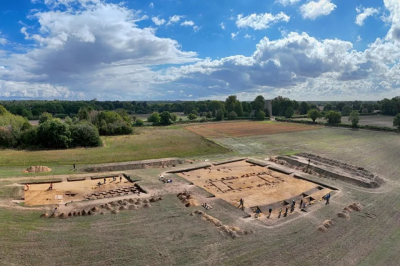 Rendlesham - Archaeologists have uncovered a possibly pre-Christian temple from the time of the East Anglian Kings at Rendlesham, near Sutton Hoo in Suffolk, England. Last year the project uncovered the remains of a large timber Royal Hall, confirming the location as a royal settlement of the East Anglian Kings. This year’s excavations also uncovered evidence of metalworking associated with royal occupation, including a mould used for casting decorative horse harnesses similar to that known from the burial ground at Sutton Hoo. The royal compound was found to have been more than twice the size than previously thought at around 15 hectares, which is equivalent to the size of 20 football pitches. The compound was part of a wider settlement complex covering around 50 hectares which is unique to the archaeology of fifth to eighth-century England. Professor Scull said: “The results of excavations at Rendlesham speak vividly of the power and wealth of the East Anglian kings, and the sophistication of the society they ruled. The possible temple, or cult house, provides rare and remarkable evidence for the practice at a royal site of the pre-Christian beliefs that underpinned early English society. “Its distinctive and substantial foundations indicate that one of the buildings, 10 metres long and 5 metres wide, was unusually high and robustly built for its size, so perhaps it was constructed for a special purpose. It is most similar to buildings elsewhere in England that are seen as temples or cult houses, therefore it may have been used for pre-Christian worship by the early Kings of the East Angles.” he Venerable Bede identifies Rendlesham as an East Anglian royal center in his Ecclesiastical History of the English People. Bede records that King Redwald, who died around AD 625 and whose grave is thought to be the Sutton Hoo ship burial, kept a temple with altars to pre-Christian Gods alongside an altar to Christ – though he does not specify where this was. This year’s excavations also discovered enclosures and evidence of earlier settlements and activities from the Neolithic (4th millennium BC), Bronze Age, Iron Age and Roman periods. These archaeological discoveries show that Rendlesham has been a favored location for human settlement and activity for 6,000 years from the fourth millennium BC to the present day, but that it was most important when a royal center during the 6th to 8th centuries AD.
Rendlesham - Archaeologists have uncovered a possibly pre-Christian temple from the time of the East Anglian Kings at Rendlesham, near Sutton Hoo in Suffolk, England. Last year the project uncovered the remains of a large timber Royal Hall, confirming the location as a royal settlement of the East Anglian Kings. This year’s excavations also uncovered evidence of metalworking associated with royal occupation, including a mould used for casting decorative horse harnesses similar to that known from the burial ground at Sutton Hoo. The royal compound was found to have been more than twice the size than previously thought at around 15 hectares, which is equivalent to the size of 20 football pitches. The compound was part of a wider settlement complex covering around 50 hectares which is unique to the archaeology of fifth to eighth-century England. Professor Scull said: “The results of excavations at Rendlesham speak vividly of the power and wealth of the East Anglian kings, and the sophistication of the society they ruled. The possible temple, or cult house, provides rare and remarkable evidence for the practice at a royal site of the pre-Christian beliefs that underpinned early English society. “Its distinctive and substantial foundations indicate that one of the buildings, 10 metres long and 5 metres wide, was unusually high and robustly built for its size, so perhaps it was constructed for a special purpose. It is most similar to buildings elsewhere in England that are seen as temples or cult houses, therefore it may have been used for pre-Christian worship by the early Kings of the East Angles.” he Venerable Bede identifies Rendlesham as an East Anglian royal center in his Ecclesiastical History of the English People. Bede records that King Redwald, who died around AD 625 and whose grave is thought to be the Sutton Hoo ship burial, kept a temple with altars to pre-Christian Gods alongside an altar to Christ – though he does not specify where this was. This year’s excavations also discovered enclosures and evidence of earlier settlements and activities from the Neolithic (4th millennium BC), Bronze Age, Iron Age and Roman periods. These archaeological discoveries show that Rendlesham has been a favored location for human settlement and activity for 6,000 years from the fourth millennium BC to the present day, but that it was most important when a royal center during the 6th to 8th centuries AD.
1,400-year-old temple from the time of the East Anglian Kings discovered at Suffolk royal settlement - Arkeonews
ANGLETERRE –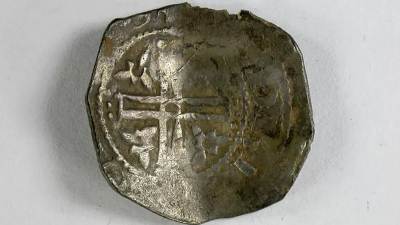 Wymondham - An unnamed metal detectorist recently discovered a scarce collection of 12th-century silver pennies near the village of Wymondham in the county of Norfolk in eastern England. This valuable cache of coins included seven pieces minted during the reign of King Stephen, an ancestor of William the Conqueror, and two more dated to the reigns of Stephen’s successors, Henry II and III. A grandson of William the Conqueror, Stephen took the throne on the death of King Henry I. However most of his reign was spent in a bitter civil war between him and his rival for the throne, Henry’s daughter Matilda. The find is made up of two pennies, three cut halfpennies and two cut quarters of pennies from Stephen’s reign, as well as two cut quarters of short cross pennies from Henry II and Henry III’s reigns.
Wymondham - An unnamed metal detectorist recently discovered a scarce collection of 12th-century silver pennies near the village of Wymondham in the county of Norfolk in eastern England. This valuable cache of coins included seven pieces minted during the reign of King Stephen, an ancestor of William the Conqueror, and two more dated to the reigns of Stephen’s successors, Henry II and III. A grandson of William the Conqueror, Stephen took the throne on the death of King Henry I. However most of his reign was spent in a bitter civil war between him and his rival for the throne, Henry’s daughter Matilda. The find is made up of two pennies, three cut halfpennies and two cut quarters of pennies from Stephen’s reign, as well as two cut quarters of short cross pennies from Henry II and Henry III’s reigns.
King Stephen 12th Century rare penny hoard found near Wymondham - Arkeonews
TURQUIE – 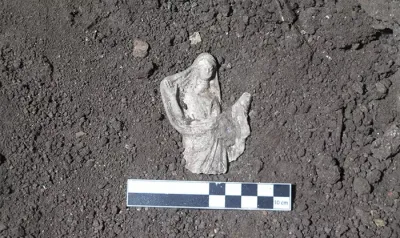 Aigai - Two statuettes of Demeter, the Greek goddess of earth and fertility, were discovered in a cistern in the ancient city of Aigai in western Türkiye’s Manisa. Aigai, also Aigaiai was an ancient Greek, later Roman, city, and bishopric in Aeolis. Aegae is mentioned by both Herodotus and Strabo as being a member of the Aeolian dodecapolis. It was also an important sanctuary of Apollo. Aigai had its brightest period under the Attalid dynasty, which ruled from nearby Pergamon in the 3rd and 2nd centuries BC. The remains of the city are located near the modern village Yuntdağı Köseler of Manisa Province, Turkey. Sezgin, who found a cistern near the road to the “sanctuary of Athena” in the city, said that they made some unexpected discoveries during the excavation. “The cistern we excavated this year is quite different from others in both its form and the artifacts found within. For example, we discovered a figurine specially placed under what we call the “cistern bracelet,” a recess at the entrance of the cistern. Normally, we don’t find such figurines inside cisterns. This one, specifically placed or laid there, depicts the goddess, Demeter, as we know from Greek mythology.” “Another interesting point is that this wasn’t the only Demeter figurine; we found another one inside the cistern, also shown in the same posture. The third discovery, which might not be very clear because it’s broken, is a piece of a decorated vase. On its fragments are sheaves of wheat, which we know are associated with the goddess Demeter,” he added. Sezgin also shared: “Demeter was the goddess of agriculture. She was the one who provided the earth’s fertility and productivity. At the same time, she was the protector of plants. In rural ancient cities like Aigai, she was one of the most important goddesses. Considering how difficult it was to farm on rural land, Demeter was given significant importance. In this regard, there was a very strong cult of Demeter in Aigai.” Special festivals and rituals for gods and goddesses were common in ancient times. Archaeologists recently discovered a cistern about 50-60 meters away from the Atena sanctuary in Aigai. This cistern might have been used for these rituals. The cistern’s proximity to the sacred area suggests it may be associated with Demeter festivals. This cistern is unique in that more figurines were discovered inside than in any other cistern.
Aigai - Two statuettes of Demeter, the Greek goddess of earth and fertility, were discovered in a cistern in the ancient city of Aigai in western Türkiye’s Manisa. Aigai, also Aigaiai was an ancient Greek, later Roman, city, and bishopric in Aeolis. Aegae is mentioned by both Herodotus and Strabo as being a member of the Aeolian dodecapolis. It was also an important sanctuary of Apollo. Aigai had its brightest period under the Attalid dynasty, which ruled from nearby Pergamon in the 3rd and 2nd centuries BC. The remains of the city are located near the modern village Yuntdağı Köseler of Manisa Province, Turkey. Sezgin, who found a cistern near the road to the “sanctuary of Athena” in the city, said that they made some unexpected discoveries during the excavation. “The cistern we excavated this year is quite different from others in both its form and the artifacts found within. For example, we discovered a figurine specially placed under what we call the “cistern bracelet,” a recess at the entrance of the cistern. Normally, we don’t find such figurines inside cisterns. This one, specifically placed or laid there, depicts the goddess, Demeter, as we know from Greek mythology.” “Another interesting point is that this wasn’t the only Demeter figurine; we found another one inside the cistern, also shown in the same posture. The third discovery, which might not be very clear because it’s broken, is a piece of a decorated vase. On its fragments are sheaves of wheat, which we know are associated with the goddess Demeter,” he added. Sezgin also shared: “Demeter was the goddess of agriculture. She was the one who provided the earth’s fertility and productivity. At the same time, she was the protector of plants. In rural ancient cities like Aigai, she was one of the most important goddesses. Considering how difficult it was to farm on rural land, Demeter was given significant importance. In this regard, there was a very strong cult of Demeter in Aigai.” Special festivals and rituals for gods and goddesses were common in ancient times. Archaeologists recently discovered a cistern about 50-60 meters away from the Atena sanctuary in Aigai. This cistern might have been used for these rituals. The cistern’s proximity to the sacred area suggests it may be associated with Demeter festivals. This cistern is unique in that more figurines were discovered inside than in any other cistern.
Two statuettes of Demeter discovered in Aigai, the 'city of goats' of the Aeolians in western Türkiye - Arkeonews
USA - Caprock Canyons - An archeology discovery at Caprock Canyons State Park uncovered the second known bison jump site in Texas. Bison roamed the Panhandle in the 1800s and were used for food by Native Americans. The process for that food came from bison jump sites, where hunters would harvest bison meat by driving a herd off a cliff. The other known bison jump site is located near Langtry along the Rio Grande. “The people that were out there had such an intimate knowledge of the landscape, that they were able to manipulate bison based off of such an extreme knowledge of bison behavior, to drive them off cliffs,” said Anna Deshotels, archeologist for Texas Parks and Wildlife Department.
VIDEO = Second known bison jump site discovered at Caprock Canyons State Park (newschannel10.com)
IRAQ – 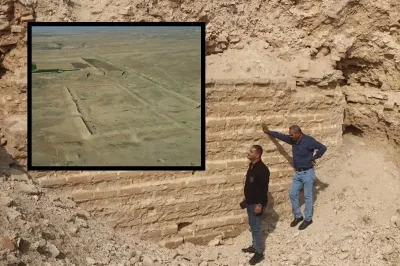 Jalula - Archaeologists have discovered traces of the ancient city of Jalula. Historical text describes Jalula as being located on the (Great) Khurasan Road, emerging as the centre of the Šāḏ Qobāḏ Province within the Sassanid Empire In AD 637, the city was fought over during the Battle of Jalula, a conflict between the Sasanian Empire and the Rashidun Caliphate. The Caliph considered Jalula an obstacle in marching on Tikrit and Mosul, so appointed Hashim ibn Utba at the head of 12,000 troops to storm the city. The Persians suffered heavy casualties and the battle ended in a complete Muslim victory. Yazdegerd III, the last reigning Sasanian king, was unwilling to send a relief force to support the city defence, which ultimately fell following a 7 month siege. After capturing Jalula, the Caliph forces pressed onto Tikrit and Mosul, and ultimately the conquest of Persia that resulted in the collapse of the Sassanid Empire. The recent survey was conducted by Ahmed Abdul Jabbar Khamas, who was able to identify landmarks and structures of the ancient city, resulting in ground level inspections that confirmed the structures.
Jalula - Archaeologists have discovered traces of the ancient city of Jalula. Historical text describes Jalula as being located on the (Great) Khurasan Road, emerging as the centre of the Šāḏ Qobāḏ Province within the Sassanid Empire In AD 637, the city was fought over during the Battle of Jalula, a conflict between the Sasanian Empire and the Rashidun Caliphate. The Caliph considered Jalula an obstacle in marching on Tikrit and Mosul, so appointed Hashim ibn Utba at the head of 12,000 troops to storm the city. The Persians suffered heavy casualties and the battle ended in a complete Muslim victory. Yazdegerd III, the last reigning Sasanian king, was unwilling to send a relief force to support the city defence, which ultimately fell following a 7 month siege. After capturing Jalula, the Caliph forces pressed onto Tikrit and Mosul, and ultimately the conquest of Persia that resulted in the collapse of the Sassanid Empire. The recent survey was conducted by Ahmed Abdul Jabbar Khamas, who was able to identify landmarks and structures of the ancient city, resulting in ground level inspections that confirmed the structures.
Archaeologists discover traces of ancient Jalula (heritagedaily.com)
ISRAEL – 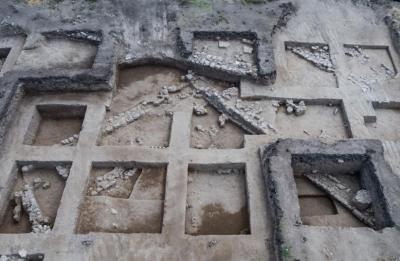
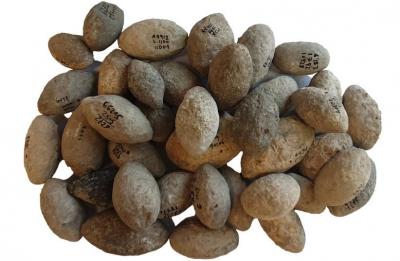 - Archaeology researchers at the Israel Antiquities Authority (IAA) have published research filling 22 pages in the spring edition (#111) of their journal ‘Atiqot (Antiquities) that has exposed the earliest evidence of warfare and organized arming in the Southern Levant: as much as 7,200 years ago. They reported that back then, there was large-scale systematic production of war weapons in the country. The production system provides key insight into the organized arming of military groups in ancient Israel. Dr. Gil Haklay, Enno Bron, Dr. Dina Shalem, Dr. Ianir Milevski and Nimrod Getzov of the Israel Antiquities Authority, the parties responsible for the research, analyzed 424 sling stones from the Early Chalcolithic period (c. 5800–4500 BCE.) All of them had been collected from two different archaeological sites: 'En Esur in the northern Sharon plain, and 'En Zippori in the Lower Galilee. All the sling stones had been almost identical, having uniformly been manufactured from hard limestone/dolomite with similar measurements of an average length of 52 mm, a width of about 321 mm, and an average weight of 60 g. The production of these weapons was likely the result of extensive community effort, with a large number of people employed solely for their construction in preparation for battle. “The stones, that were intended to be projected from a sling, are smoothed, with a specific biconical aerodynamic form, enabling exact and effective projection,” explained the archaeologists. “Similar sling stones have been found at other sites in the country, mainly from the Hula Valley and the Galilee in the north to the northern Sharon, but this is the first time that they have been found in excavations in such large concentrations. “These stones are in fact, the earliest evidence of warfare in the Southern Levant,” the researchers said. "The similarity of the sling stones points to large-scale industrial production. The effort put into the aerodynamic form and the smoothing of the stones’ surface indicate that they were intended to be exact and deadly weapons."
- Archaeology researchers at the Israel Antiquities Authority (IAA) have published research filling 22 pages in the spring edition (#111) of their journal ‘Atiqot (Antiquities) that has exposed the earliest evidence of warfare and organized arming in the Southern Levant: as much as 7,200 years ago. They reported that back then, there was large-scale systematic production of war weapons in the country. The production system provides key insight into the organized arming of military groups in ancient Israel. Dr. Gil Haklay, Enno Bron, Dr. Dina Shalem, Dr. Ianir Milevski and Nimrod Getzov of the Israel Antiquities Authority, the parties responsible for the research, analyzed 424 sling stones from the Early Chalcolithic period (c. 5800–4500 BCE.) All of them had been collected from two different archaeological sites: 'En Esur in the northern Sharon plain, and 'En Zippori in the Lower Galilee. All the sling stones had been almost identical, having uniformly been manufactured from hard limestone/dolomite with similar measurements of an average length of 52 mm, a width of about 321 mm, and an average weight of 60 g. The production of these weapons was likely the result of extensive community effort, with a large number of people employed solely for their construction in preparation for battle. “The stones, that were intended to be projected from a sling, are smoothed, with a specific biconical aerodynamic form, enabling exact and effective projection,” explained the archaeologists. “Similar sling stones have been found at other sites in the country, mainly from the Hula Valley and the Galilee in the north to the northern Sharon, but this is the first time that they have been found in excavations in such large concentrations. “These stones are in fact, the earliest evidence of warfare in the Southern Levant,” the researchers said. "The similarity of the sling stones points to large-scale industrial production. The effort put into the aerodynamic form and the smoothing of the stones’ surface indicate that they were intended to be exact and deadly weapons."
Earliest production of weapons dating back 7,000 years found in Israel - The Jerusalem Post (jpost.com)